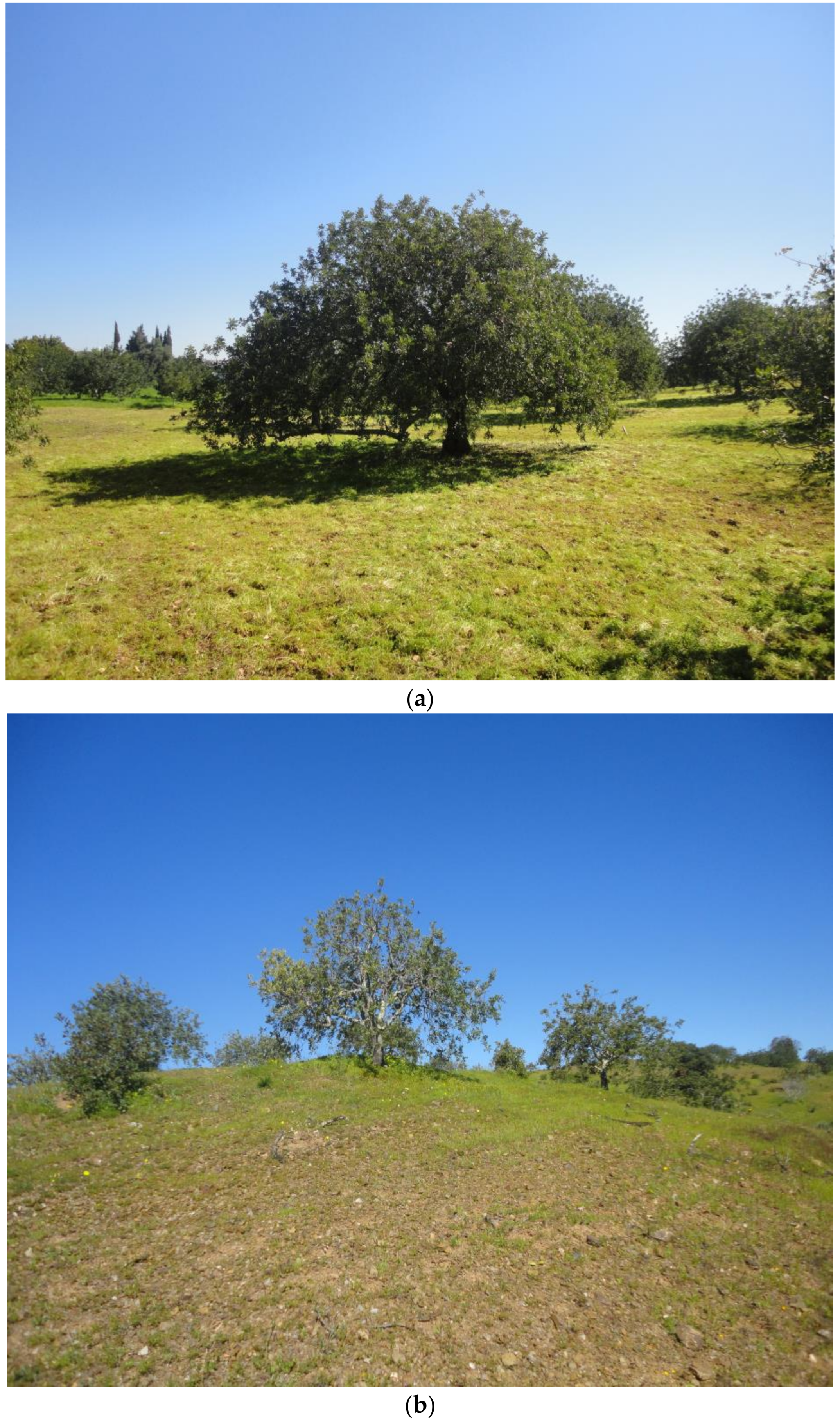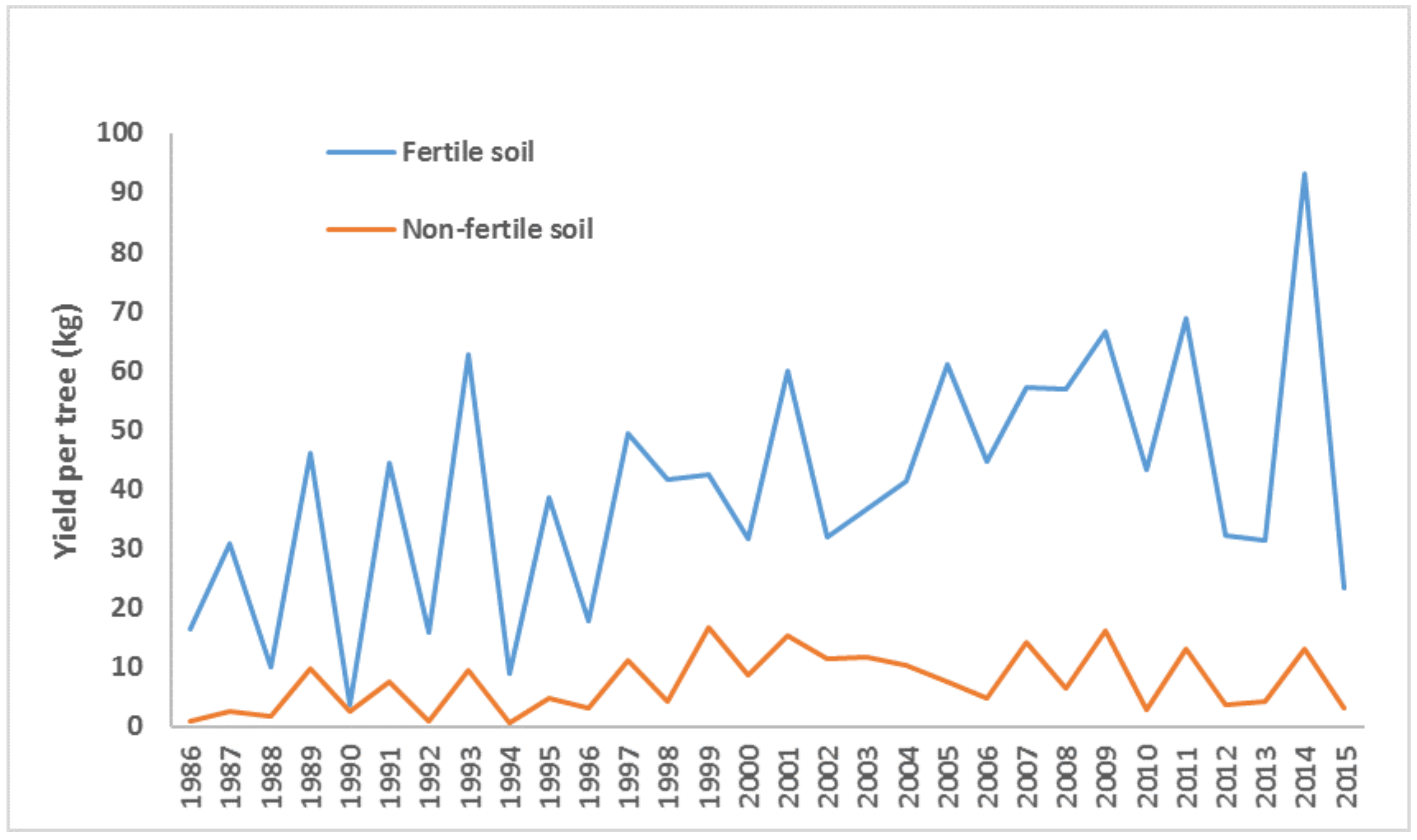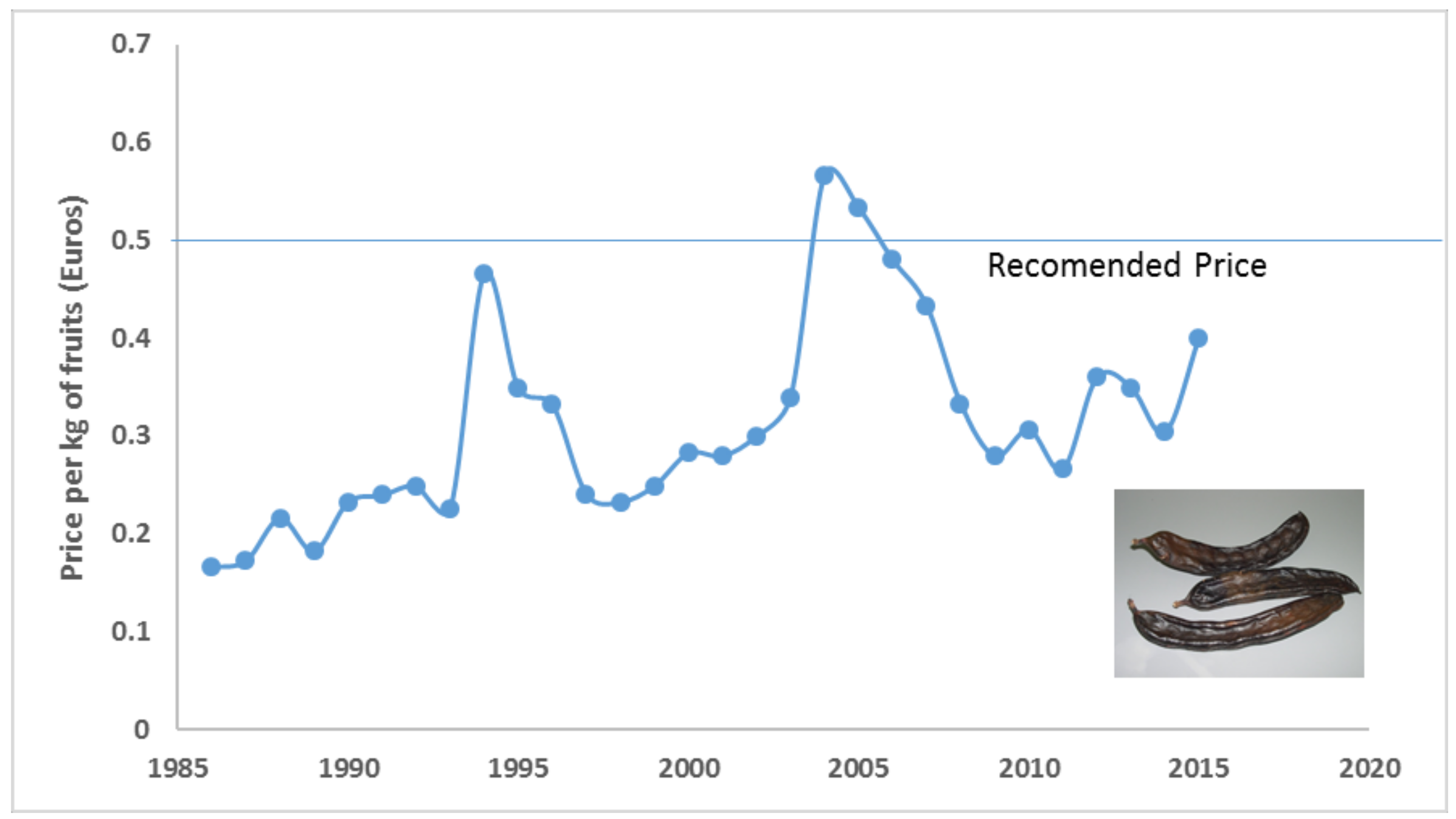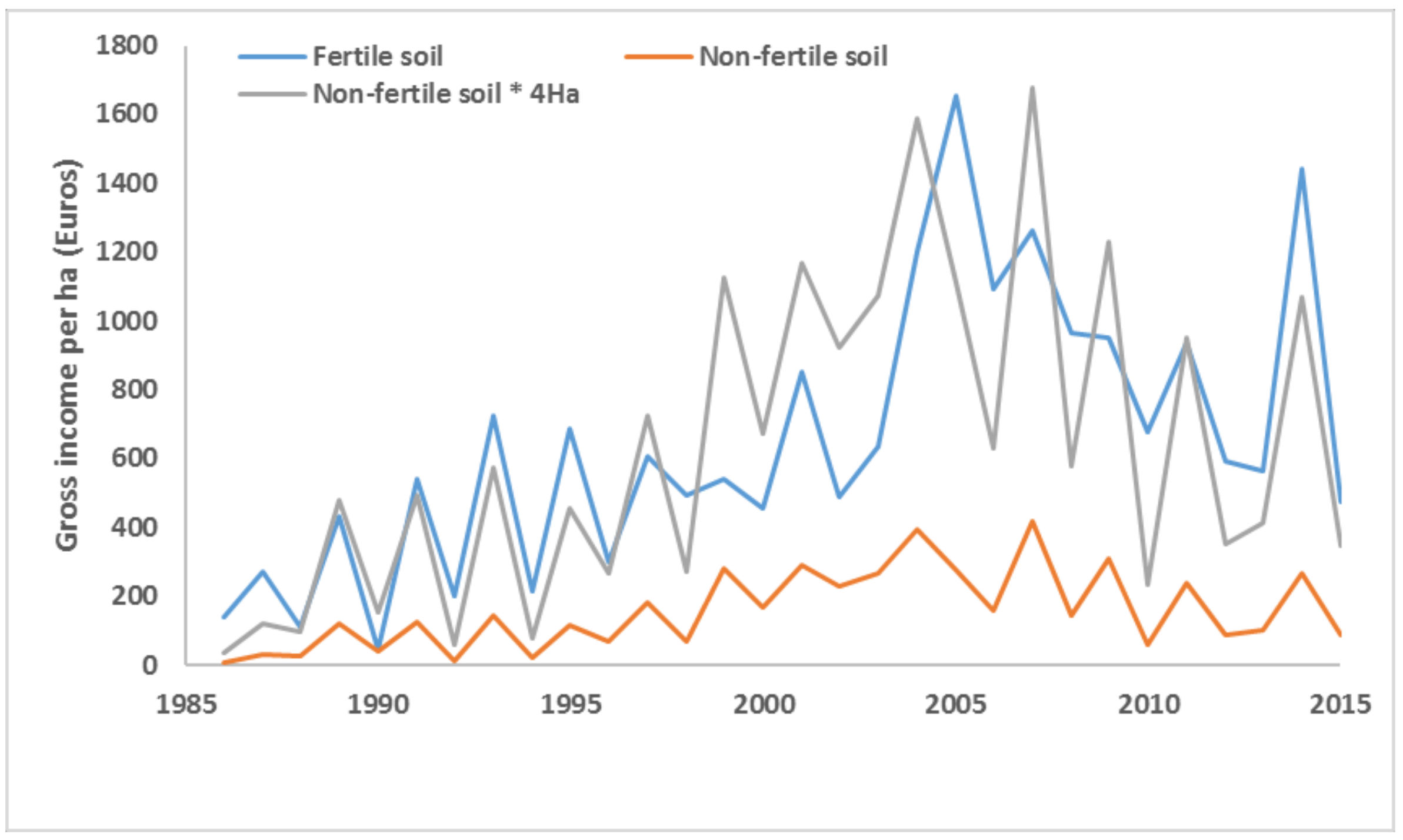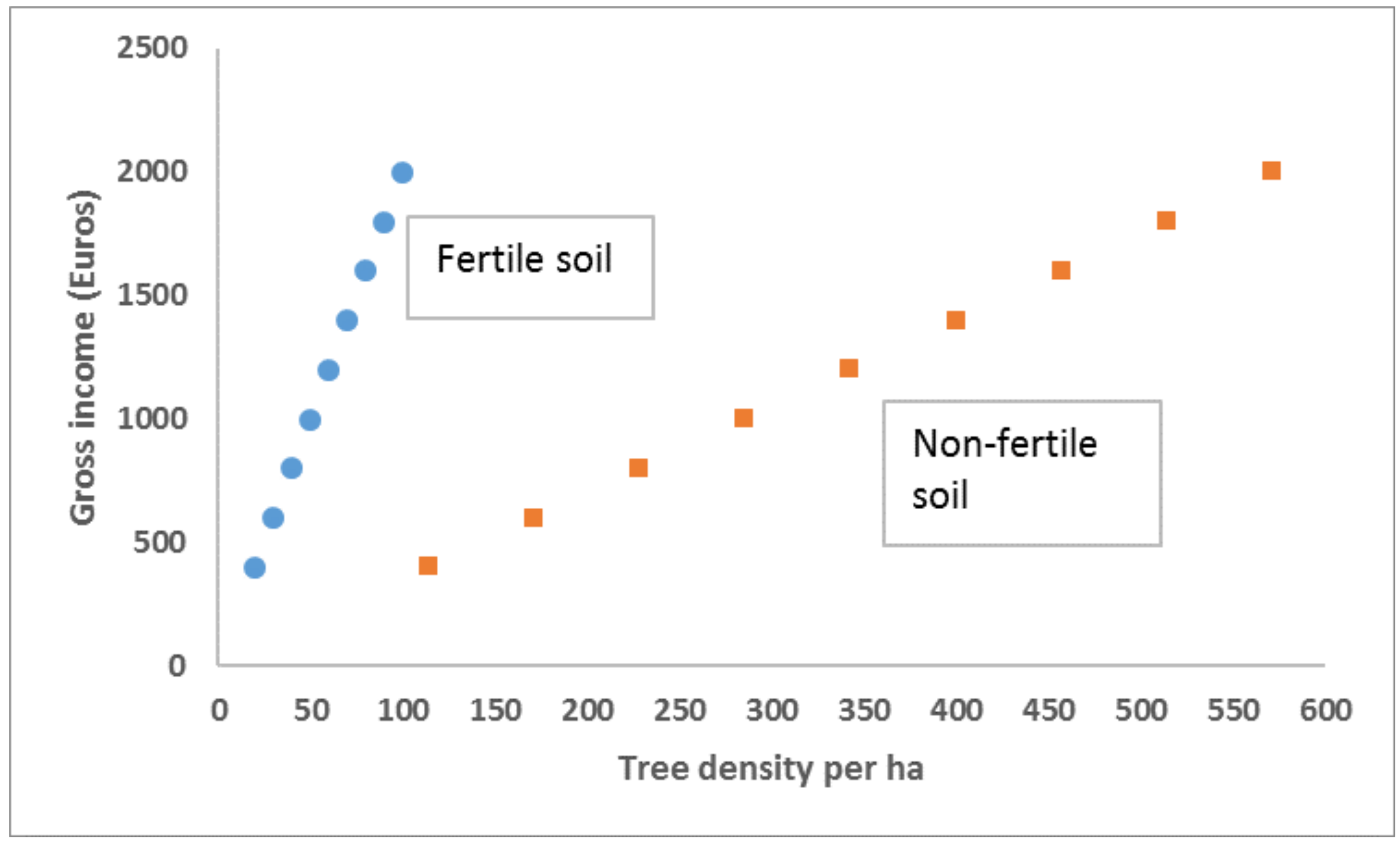1. Introduction
Carob tree (
Ceratonia siliqua L.) is a woody tree species cultivated all over the Mediterranean region, which presents a great ability to grow under different edaphic conditions [
1]. It is tolerant to water and soil nutrient stress (e.g., low N and P) due to a marked ecological plasticity, possessing several types of physiological and morphological resistance and tolerance mechanisms [
1,
2]. Currently, it is an industrial crop and Portugal is the third top producer, globally, of carob, a dry pod that is used for animal feed and human food [
2]. Several interesting compounds may be extracted from the pulp (sugars, polyphenols) or seeds (proteins, vitamins, and amino acids) and used in the pharmaceutical and nutraceutical industry [
3,
4].
One of the greatest concerns of the carob industry at the transnational level is the regional availability of pods, which must be consistent and regular year round. The problem arises when fruit production in the region decreases. In general, there is a positive effect of summer irrigation and N fertilization on tree performance [
1], but the majority of carob tree orchards are not irrigated and do not receive mineral fertilizers, thus relying mostly on favourable pedo-climatic conditions during the crop cycle. Carob tree is well adapted to different soil types, providing that excessive soil water accumulation in the root zone can be avoided. Calcareous soils with medium to high soil organic matter are the best soils to grow carob tree, but less fertile soils (low organic matter) with no calcium carbonate may also be used, revealing the high ecological plasticity of this crop [
1,
2]. Economic return and long-term variation of gross income in these two contrasting ecosystems—calcareous soil (“Barrocal” region) and non-calcareous soil (“Serra” region)—have never been studied and compared.
The objective of this exploratory analysis is to provide basic information regarding the long-term variation of fruit production in two orchards, grown in two different soils in Southern Portugal. This information may support future measures of supporting agricultural policies in marginal regions chronically affected by desertification and rural abandonment.
2. Materials and Methods
The study was conducted in two different orchards. The orchard in the Barrocal region with a total area of 4.3 ha was located in Castro Marim (37°20′ N, 7°44′ W). Trees of the cultivar “Mulata”, particularly suited to industrial purposes, are more than 50 years old and are established at a density of 51 trees per ha. The soil is a clay-loam soil comprised of 16% active lime. At 30–40 cm depth, the pH(H2O) is 8, with low values of extractable P and medium values of extractable K. Organic matter (OM) is 4.1%. No irrigation and no mineral fertilization is applied, although some OM is occasionally incorporated in the soil surface. Soil is tilled once or twice per year. Overall, the cultural practices of this orchard are minimal, thus, we may consider this a low input farming system, where tree productivity mostly relies on favourable seasonal environmental variations. The soil of the orchard is suitable for carob tree development, and based on soil chemical analysis, no major nutritional limitations are expected to occur at the site.
The orchard in the Serra region, located in Junqueira (37°26′ N, 7°46′ W), is established in a sandy-loam soil, with no active lime (0%), with low values of extractable P and medium to low values of extractable K, and with 1.6% of OM. The pH(H2O) is 5.8. Applications of OM in this site are rare and sparse. The density is 68 trees per ha, and the total area of the orchard is 43.8 ha. The cultivar is also Mulata, and the orchard age is similar in this second site. Although it is not possible to indicate with accuracy the exact age of the trees, both orchards reach their maturity in terms of yield potential. Both orchards belong to the same farmer, thus, the cultural practices and soil management are quite similar. The climate of both locations is a typical Mediterranean with hot summer and mild winter (Cs according to Köppen classification) similar since they are located only 7 km apart. Mean annual air temperature is 16.5 °C and precipitation is around 500 mm per year.
Yield data (fruit production) was collected from the farmer’s inventory and reported to the period 1985–2015. The price per kg of pods was also obtained from farmer. Yield data used in this exploratory study is in kg of pods per tree, collected at harvest (late summer). The values per tree were calculated based on the total yield per ha and dividing this value by the total number of trees. No male trees were found within the selected areas, but male trees were found in adjacent areas. Two response models (to each soil type) were proposed to predict gross income as a function of increasing tree density. Multiplying 0.50 euros per kg and assuming the average of fruit production for each site, a total gross income per tree was obtained. Subsequently, the gross income per ha according to projected tree density, was calculated and plotted.
One-way analysis of variance was used to compare yield per tree in the two sites, by using SPSS software (IBM, SPSS Statistics for Windows, version 23.0, Armonk, NY, USA).
3. Results
In
Figure 1a, mature carob trees in a traditional low-density orchard in the calcareous soil of the Barrocal region are shown. Trees with similar ages, but grown in a non-calcareous and less fertile soil of the Serra are much less developed, as can be seen in
Figure 1b.
The variation of fruit production per tree in both locations is observed in
Figure 2.
The differences between the two locations were clear, and mostly reflects the effect of soil (
Table 1). The pattern of yield is also variable for each situation. In the fertile soil of Barrocal, there was an “on-off” yield pattern between 1986 and 1996, which was not observed in the following decade. Between 2011 and 2015 that “on-off” outcome seemed to occur again. On the contrary, the fruit production of trees in the low-fertility soil, wass extremely low, although the same yield variation pattern between years may be seen.
In
Figure 3, the variation of the fruit’s price from 1986 to 2015 is shown. The value of kg of carob pods was low compared to the value used as reference in the region. Accordingly, only in 2004 and 2005 was the value above that threshold level. If we consider the production per hectare for each region and take into account the densities of 51 and 68 trees per ha, respectively, for fertile and non-fertile soil, the variation of gross income per ha and per year is presented in
Figure 4. In the first case (fertile soil) the average of fruit production income was 652 Euros per ha (±392 Euros, s.d.), whereas in non-fertile soil it decreased to 158 ± 113 Euros (75% less). To reach the values obtained in the fertile soil (mean = 652 Euros), at least 4 ha of non-fertile soil in the Serra region would be needed, despite the high variation between years.
Figure 5 shows the variation of gross income in relation to the increase of tree density.
The models considered the recommended price of 0.50 Euros per kg and an average of 40 kg and 7 kg of fruit per tree, respectively, for fertile and non-fertile soil. To obtain the maximum gross income in the Serra region, and considering a low tree productivity (7 kg per tree), 571 trees per ha would be required.
4. Discussion
Portugal is the third top carob producer in the world [
2], and the cultivation of carob tree is practically restricted to the southern province (Algarve). Carob tree is an industrial crop since the fruits (all of its components: pulp, seeds, and embryos) and leaves, are processed by local industry. Carob byproducts are then exported worldwide, representing a positive economic return of 11.4 million Euros (the average of 2010–2015, [
5]). The seed and pulp industry (mainly kibblers), therefore, acquire all the available production after harvest (late summer) ensuring a consistent and regular demand throughout the season. The cultivated area with mature and productive orchards is currently around 9000 ha, but if we also consider other agrosystems, such as carob mixed orchards (with almond, fig, and olive trees), semi-abandoned orchards, urban areas, and gardens, a rough estimate indicates around 80,000 ha.
The most productive orchards grow in the calcareous soils of the Barrocal region. These soils have a higher water holding capacity and normally shows higher K, Ca, and Mg content. These chemical characteristics may explain the higher yields reported in this study for the Castro Marim site, despite the large variation between years (an average of 40 ± 20 kg, s.d.). Contrastingly, the soils of “Serra”, which represents more than 50% of the total area of the province, are much less fertile, with very low levels of OM (0–1%), and low levels of P [
6]. These conditions are similar to those found in the non-fertile soil of this study (Junqueira site), where extremely low yield was observed (an average of 7 ± 5 kg). In this marginal soil, at least four ha of non-fertile soil are needed to meet the gross income obtained in the fertile soil. This is not unrealistic, since the average of the land area per farmer operating in the Serra region is greater than 10 ha. This is a reasonable option for land-use in marginal soils since it allows a continuous mosaic of carob tree orchards, providing a complementary annual income. However, the very low price payed to farmers associated to the high yield irregularity still constitutes two major constraints. This irregularity, sometimes a marked “on-off” pattern, is apparently not related to climatic conditions, but rather due to endogenous metabolic factors, as found by Haselberg [
7] in this region, turning into a very difficult, and complex to describe and predict tree productivity, which is a crucial issue to the carob industry.
Taking into consideration the results described above, how can we maintain the sustainability of the system for carob tree/land use? Increasing tree density may be an option, but in non-fertile soils this option is not realistic since the demand for water and soil nutrients increases [
1,
2]. Higher tree densities (>200 trees per ha) imply external inputs, such as drip irrigation during spring and summer, and mineral fertilization (N, P, and K), representing additional costs to the farmer. We believe that if the price is consistently low, most of them will not be willing to invest in those external resources. Moreover, and in the case where water is available to irrigate agricultural crops, the options easily fall to
Citrus trees or horticultural crops.
Taking into account the climatic change scenario in the Iberian Peninsula [
8], the sustainability of the carob tree agroecosystems conducted under dry-farming conditions requires novel perspectives. Several new compounds have been identified in carob pulp [
9], and some of them are related to soil properties [
10], but a regular demanding market for these products should be implemented. Finally, tree carbon sequestration potential should be clearly assumed [
11] as a new source of income, otherwise we might assist in the long-term depreciation of this traditional crop in Southern Europe.
